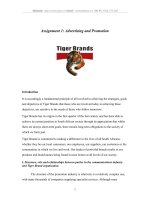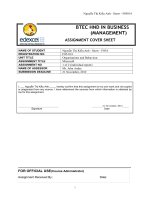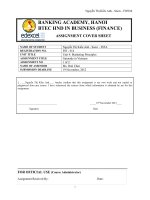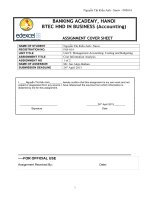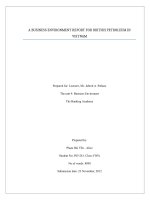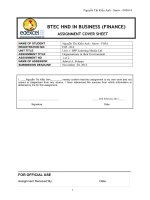Lei3025 assignment 1 individual inspection report
Bạn đang xem bản rút gọn của tài liệu. Xem và tải ngay bản đầy đủ của tài liệu tại đây (959.21 KB, 12 trang )
ABSTRACT
Visitors to the hotel require many other convenient services in addition to resting.
Whether a hotel is high-class or low-cost, the services provided are intended to
satisfy visitors. The study uses qualitative observational analysis to present service
quality's positive and negative aspects at a hotel bakery. Finally, there are some
suggestions for improving bakery service quality based on customer service
theories.
i
TABLE OF CONTENTS
ABSTRACT................................................................................................................i
TABLE OF CONTENTS.........................................................................................ii
1. INTRODUCTION............................................................................................1
2. Relevant theories to service quality and additional services in the
hospitality industry...............................................................................................2
3. Service evaluation.............................................................................................2
3.1. Positive aspect.........................................................................................3
3.2. Negative aspect.......................................................................................4
6. Recommendation..............................................................................................5
7. Conclusion.........................................................................................................7
8. References..........................................................................................................8
ii
1. Introduction
The hotel business market is becoming more active today, with many hotels of
various sizes, capital, and ownership structures. As a result, market competition is
becoming increasingly fierce (Roy and Mani, 2022). Furthermore, as
socioeconomic development grows, so do customers' needs, who want to be served
in the best way possible at a reasonable price. Furthermore, a prominent feature of
services in general, and complementary services in particular, is that they are easily
imitated because service production and consumption occur concurrently. When
confronted with this situation, when the hotel's product and service system is still
not diverse and rich, and there is no competitive advantage, the hotel must develop
a research plan to improve and develop its service system. Only then will the hotel
be able to operate effectively in the current environment.
Because hotel guests are tourists, they have the ability to pay more than
regular spending. As a result, tourism demand is frequently referred to as luxury
demand. According to the name feature, the hotel needs to diversify its products and
improve product quality to meet the increasing needs of guests. Following the end
of the Covid 19 pandemic, some of the hotel's products and services will be
invested in food, bars, laundry, four-season swimming pools, fitness centres, spa
services, meeting room services, and airport shuttle service. In addition to the
services listed above, some luxury hotels may provide babysitting, golf course
service, tennis court, self-driving car rental service, flight ticketing support service,
tickets for sightseeing tours, and karaoke services.
This study aims to investigate relevant theories on service quality and
additional service. Based on these theoretical foundations, the essay analyzes
qualitatively by observing different service quality at a bakery in the Goldermark
hotel service chain. The final content consists of theoretically based
recommendations for bakeries to improve service quality.
2. Relevant theories to service quality and additional services in the
hospitality industry
The tourism industry is highly fragmented, with many sectors and sub-sectors
catering to visitors' needs. Visitors interact with various service providers, and the
interaction process and service delivery reflect essential aspects of the tourism
consumption process, such as value, quality, and satisfaction. In a nutshell,
hospitality service quality is determined by comparing the quality expected to the
quality of service received by the customer (Laws, 2001). Hotel service quality is
defined as the level of customer satisfaction by service consumers.
From the manufacturer's perspective, service quality is the assurance of
providing the service in accordance with the scenario using the highly professional
skills of the supply staff and management team (Raval, 2012). From the customer's
perspective, service quality is the level of customer satisfaction during service
consumption, as well as the overall service of the company that brings a chain of
benefits and fully satisfies the expected demands of customers, commensurate with
the costs that customers must pay.
1
Zeithaml defined service quality in 1988 as "an assessment of customers
based on the overall excellence of services." Although researchers generally agree
on the importance of service quality in customer satisfaction and firm performance,
there is no agreement on a model for measuring service quality. Service quality is
multidimensional (Brady & Cronin, 2001), with different dimensions depending on
the service industry. Nonetheless, service quality measurement enables managers to
identify problems in the service provided to customers in order to improve
efficiency and quality in order to satisfy customers and fulfil their desires.
Service quality has been extensively researched since the early 1980s when
Gronroos introduced the Nordic model, the first model for measuring service
quality. He believes that technical qualities should be distinguished as an outcome
of service performance from functional qualities as a subjective perception of the
service provided. In 1985, Parasuraman, Zeithaml, and Berry introduced a new
approach called SERVQUAL, the most well-known and widely used model in
service quality. They initially proposed ten dimensions for their model, but in the
1988 revision, they reduced the dimensions to five. The foundation of this model
was based on measuring the differences between customer expectations and
perceptions of the service provided via five suggested dimensions.
Additional services are services provided to customers to satisfy nonmandatory needs, such as essential services, which must be present in the service
business (Kethuda and Agras, 2017). The essence of the supplementary service is to
add value to the primary service and facilitate guests' use of the basic service. The
supplementary service must have a synchronous, correlated relationship with the
basic service. Additional services help to meet the maximum needs of customers,
prolong the business season, improve competitiveness, create more jobs and
increase revenue for the hotel.
3. Service evaluation
The author used the qualitative observation method to collect information on
the characteristics and factors affecting service quality at the bakery on the 4th floor
of the Goldmark Hotel, a 3-star hotel in Hanoi located at 136 Ho Tung Mau. The
bakery shop specializes in providing all types of bread and cakes using only natural
ingredients and avoiding the use of additives. Products range from bread to cakes,
ideal for birthdays, weddings, or any other event. The bakery's passion is to provide
fresh, high-quality bakery products to the hotel residential community that delight
customers and make anniversaries the most treasured moments.
2
Figure 1: Bill on 5/6/2022
Figure 2: Bill on 21/6/2022
In order to obtain objective evaluation results, service quality is assessed
several times per day during peak and off-peak hours. Direct observation of the
phenomenon under study is a valuable tool in the field of service quality because it
informs us about its characteristics and influencing factors (Ghildiyal et al., 2022).
Capability to describe and explain behaviour, collect complete and reliable data
corresponding to identified behaviours, events, and situations, and place ideally in a
theoretical context.
3.1. Positive aspect
One of the prerequisites for a successful restaurant business is the restaurant's
location(Hanaysha, 2016). Customers at the hotel cannot travel far because the
lunch break is so short. As a result, they prefer to eat in the building or walk quickly
to a nearby restaurant, which is more convenient than ordering fast food delivery
but saves time and money. The store is on the fourth floor of the Goldmark hotel,
with windows overlooking An Binh lake. It is a popular destination for office
workers as well as primary and secondary school students.
This pastry shop has a fresh atmosphere that makes it convenient for
domestic and foreign visitors to eat. Because the restaurant receives a large number
of international guests, this is one of the most critical factors in promoting its
business. The staff is very young, dynamic, and enthusiastic, and they work with a
complete system of technical facilities to meet the customers' needs as quickly and
efficiently as possible. The restaurant's business activities have grown thanks to
diverse and modern equipment.
3
Figure 3: Manager Store Le Dang Dung
The furniture arrangement in the bakery is scientific and airy, with a modern
and dynamic style that still exudes luxury. The product layout is eye-catching, easy
for users to select, and ensures impressive consumer attraction. Cake shops that use
materials that have sound lighting effects will save money on electric lights. Aisles
between counters and airy shelves make the most of the pastry shop's space without
taking away from it.
Figure 4: Toast, pan, snack, and sweetbreads on showcases
3.2. Negative aspect
A portion of the bakery's service staff is unprofessional, and the level of enthusiasm
does not match the restaurant's motto. Even though there were many people talking
at the counter, the food was still slow to arrive. Customers will feel more at ease if
the staff is friendly, even if they have to wait a long time. The bakery manager
should provide specific instructions so employees can interact with customers
flexibly while still adhering to the company's requirements. Customer service
representatives must be trained to deal with stressful situations with customers
(Salomonson et al., 2012). This employee factor is reflected in many ways, but most
are in employees' friendliness with colleagues and customers and their respect for
work and the workplace. Furthermore, professional behaviour is reflected in the
observance of uniform regulations and personal hygiene, as well as the handling of
personal matters during working hours.
4
The bakery's lighting system is still dim and in need of improvement. It is
not recommended to install a single light line, but rather to combine light colours
such as yellow and white light into one system so that the bakery can change the
light colour to better match the weather. The pastry shop will have magical seasonal
effects as a result of this.
Figure 5: The check-out counter
Many items on equipment are scratched, old, and worn; staff uniforms are
tainted, and sometimes the thread is chipped. The lack of tools and the unsanitary
conditions persist; the aisle between the store and the grill lacks an empty carpet,
making it difficult for staff to move; and the menu remains limited, often repetitive,
and challenging to meet the needs of customers.
6. Recommendation
Working in the service sector Hospitality is a highly emotional experience.
Because the customer's perception determines the final product's quality, hoteliers'
mission is to please as many guests as possible while attempting to change the
unsatisfactory ones who remain. This study makes some recommendations for the
bakery's human resources, facilities and menus. Product and service characteristics
5
are labour intensive (Wynn and Mueller, 1998). The service staff who have direct
contact with customers should significantly impact the pastry shop's success. As a
result, an effective solution for fast food service development is to first and
foremost train staff with professional skills and good service capacity and instil in
employees love of the profession, personality, and ethics. Human psychology is
always on the lookout for new information. They frequently ask questions in order
to obtain answers. As a result, restaurant employees must not only serve food and
drinks but also be knowledgeable enough to answer customers' questions politely
and confidently. To accomplish this, the restaurant must organize training to
provide accurate information; the rest depends on the staff's awareness, concern,
and seriousness. The most common example is remembering loyal customers'
names and preferences but not forgetting and being skilful when proactively
suggesting new accompanying dishes that will most likely suit their needs. As a
result, both customers and staff save time, and diners have more exciting options.
Along with labour and human resources, technical facilities and equipment
are critical in improving the quality of food services (Bangal, 2020). The store must
invest in equipment to ensure uniformity, regular maintenance, repair, and
equipment arrangement. When used in processing and employee work, the water
supply and drainage system must also pay attention to the utility. Technical baking
facilities require more attention, as do labour protection tools, uniforms, lockers,
and storage to ensure scientific orderliness and convenience. Items must be picked
up regularly, and cleaning chemicals must be added. Chemicals must be used in
accordance with each item to arrange the placement of gas stoves, grills, and water
systems to facilitate preliminary processing and raw material processing.
Figure 6: Product diversification is the most effective way to attract customers to
the store.
According to Kučerová et al. (2013), product diversification is the process of
expanding a company's product portfolio to meet the needs of the market and
society while remaining appropriate to the business environment conditions to
create a reasonable and adequate product structure. To diversify effectively,
businesses must consider the relationship between product diversification and
production and business planning and the relationship between diversification and
production organization. Today's cultural environment has changed people's dietary
needs, necessitating a wide range of bakery and beverage products. The bakery
6
must modernize its dishes, offer various servings, create various tastes for diners to
choose from, and come up with impressive names for their dishes to stay on trend.
Additionally, there is a variable price for each portion, meal, and food product,
which must also be seasonally appropriate. In addition to expanding the menu, the
restaurant must maintain food hygiene, closely monitor the purchasing process of
raw materials, select fresh ingredients to ensure quality, and store them properly.
7
7. Conclusion
Tourism is now regarded as an essential industry and a critical economic
sector in many countries around the world. As a result, in order to expand their
business activities, companies must have extensive relationships with customers and
service providers. Along with that, service packages and products in the hotel are
indispensable factors that affect customer satisfaction. These services include bars,
laundry, four-season swimming pools, fitness centres, spa services, restaurants and
bakeries. This study has raised several theories related to service quality and
additional service, thereby making objective comments on the service quality of a
bakery on the 4th floor of the Goldenmark hotel. In the end, this study offers some
recommendations based on relevant theories to enhance the bakery service quality.
<2143 words>
8
8. References
Parasuraman, A. Zeithaml, V. A. and Berry, L. L. (1985) A Conceptual
Model of Service Quality and Its Implications for Future Research. Journal of
Marketing, 49(4), pp.10.
Gronroos, C. (1982) Strategic Management and marketing in the service
sector (1st ed.):Helsingfors: Swedish school of Economics and Business
Administration.
Brady, M. K., and Cronin, J. J. (2001) Customer Orientation: Effects on
Customer Service Perceptions and Outcome Behaviors. Journal of Service
Research, 3(2), pp.241-251
Bangal, V. (2020) Importance of “Non-Technical Skills” in Improving
Quality of MCH Services. Women's Health Science Journal. 4(2), pp.1-2
Hanaysha, J. (2016) Restaurant Location and Price Fairness as Key
Determinants of Brand Equity: A Study on Fast Food Restaurant Industry. Business
and Economic Research. 6(1), pp.310
Zeithaml, V. A., & Berry, L. L. (1985) A Conceptual Model of Service
Quality and Its Implications for Future Research. Journal of Marketing, 4(3),pp.10
Kethuda, O. and Agras, S. (2017) Effect of satisfaction from after-sales
services provided in authorized automobile services on recommendations to other
customers. Pressacademia. 3(1), pp.691-699
Kučerová, J., Šottníková, V. and Nedomová, Š. (2013) Influence of dietary
fibre addition on the rheological and sensory properties of dough and bakery
products. Czech Journal of Food Sciences. 31(No. 4), pp.340-346
Laws, E. (2001) Service Problems, Service Crises and Service Disasters.
Journal of Quality Assurance in Hospitality & Tourism. 2(1-2), pp.119-129
Raval, T. (2012) A Perspective on Service Quality and Closing Service
Quality Gaps. Paripex - Indian Journal Of Research. 3(8), pp.83-85
Roy, S. and Mani, D. (2022) VC’s in an Emerging Market: Becoming
Increasingly Diversified with Experience:. Academy of Management Proceedings.
2022(1)
Salomonson, N., Åberg, A. and Allwood, J. (2012) Communicative skills
that support value creation: A study of B2B interactions between customers and
customer service representatives. Industrial Marketing Management. 41(1), pp.145155
Wynn, T. and Mueller, C. (1998) Product Characteristics, Human Capital,
and Labor Market Segments: Services and the Distribution of Rewards in Labor
Market Transactions. The Sociological Quarterly. 39(4), pp.597-622
Ghildiyal, A., Devrari, J. and Dhyani, A. (2022) Quality of healthcare service
and its influencing factors. International journal of health sciences. , pp.8609-8622
9
10
